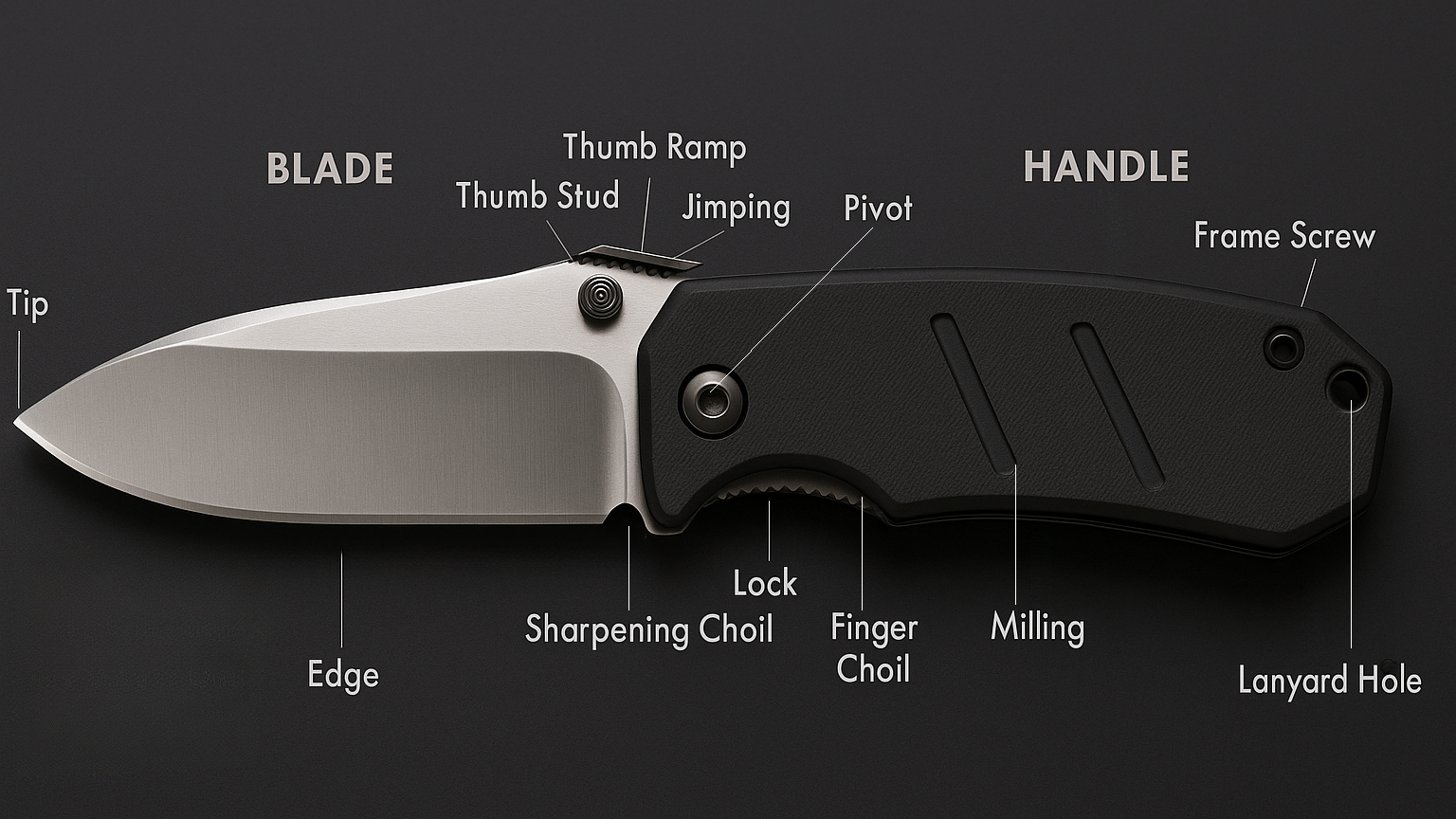
A folding knife is one of the most practical and enduring tools ever created. Compact, versatile, and designed for everyday use, it serves everyone—from outdoor enthusiasts to tradespeople to those who simply appreciate a dependable item in their daily carry.
This guide explains exactly what a folding knife is, how it works, its history, and how to choose one that meets your needs.
A folding knife is a knife with one or more blades that pivot into the handle, allowing the entire tool to be compact, safe, and portable. When closed, the blade is fully housed inside the handle to prevent accidental injury. This type of knife is also commonly known as a pocketknife or jackknife.
Unlike fixed-blade knives—which offer maximum strength for demanding tasks—a folding knife prioritizes portability, convenience, and everyday versatility, making it ideal for EDC (everyday carry).
Although the terms are often used interchangeably, there are important distinctions:
| Term | Meaning | Key Feature |
|---|---|---|
| Folding Knife | General term for any knife with a pivoting blade | Folds into handle |
| Pocket Knife | Folding knife small enough for pocket carry | Compact size |
| Lock Knife | Folding knife with a mechanism that locks the blade open | Enhanced safety |
Most lock knives are folding knives, but not all folding knives have locks.
The folding knife is far older than most imagine. Archaeological discoveries reveal its evolution across cultures and centuries.
The earliest known folding knives were simple friction folders with bone handles found in Central Europe.
Ancient Roman craftsmen produced folding knives from bronze or iron. These knives were used for eating, grooming, and daily tasks.
Friction folders continued to be common workmen’s tools due to their simplicity and low cost.
The introduction of a backspring to keep the blade open marked a major leap forward. This “slip joint” design eventually inspired multifunctional pocket tools.
Today’s folding knives feature advanced steels, precision pivots, ergonomic handle materials, and a wide range of locking mechanisms designed for safety and performance.

Understanding the components helps you evaluate quality and choose the right design.
The working edge of the knife, available in shapes like drop point, clip point, and tanto. Blade steel affects edge retention, corrosion resistance, and toughness.
Houses the blade when closed and provides grip. Common materials include G10, micarta, aluminum, stainless steel, and titanium—each offering a different feel and durability level.
The rotating joint that allows the blade to open and close. Modern pivots often use washers or ball bearings for smoother action.
Prevents the blade from folding shut during use, enhancing safety and control.
Lock type is one of the most important features of a modern folding knife. Each mechanism offers unique advantages.
A spring-loaded liner moves behind the blade to secure it. Easy to operate with one hand.
A portion of the handle frame locks the blade, creating a stronger and more rigid mechanism.
A spine-mounted bar engages a notch on the blade. Known for strength and reliability.
A button disengages the lock. Common on automatic knives but also used on manual folders.
A tensioned bar slides to lock and unlock the blade. Fully ambidextrous and strong, ideal for work environments.
| Lock Type | Strength | One-Hand Operation | Ambidextrous | Best For |
|---|---|---|---|---|
| Liner Lock | Medium | Yes | Right-hand dominant | EDC |
| Frame Lock | High | Yes | Mostly right-hand | Premium folders |
| Lockback | High | No | Yes | Outdoor use |
| Button Lock | Medium | Yes | Yes | General EDC |
| Axis-Style Lock | High | Yes | Yes | Work & utility |
A folding knife is valued for its versatility across daily tasks and outdoor environments—similar to many outdoor and everyday pocket knife uses.
The folding knife succeeds because it strikes a balance between compactness, safety, and utility.
Compact design fits easily in a pocket or bag.
The blade stays protected when closed, reducing accidental cuts.
One tool handles a wide range of daily and outdoor tasks.
Less intimidating and easier to carry than a fixed blade.
Selecting a folding knife depends on how you intend to use it.
Choose steels with the right balance of:
Pick a lock that matches your safety and comfort level.
G10 and micarta for grip, aluminum for lightweight carry, titanium for premium performance.
Consider pocket clips, deep-carry designs, and ambidextrous options.
Is a folding knife safe to carry daily?
Yes. When closed, the blade is securely contained within the handle, and modern locks further improve safety.
Are folding knives legal everywhere?
Knife laws vary widely by region. Always review local regulations regarding blade length and locking mechanisms.
What blade steel is best for everyday carry?
It depends on your priorities: corrosion resistance, edge life, or ease of sharpening.
How long do folding knives typically last?
With proper care, a quality folding knife can last many years due to durable steels and reliable mechanical designs.
Can a folding knife replace a fixed blade?
For most daily tasks—yes. But for heavy-duty or survival use, a fixed blade offers superior strength.
A folding knife is more than a compact tool—it's a practical, time-tested companion that blends convenience with capability. From ancient friction folders to today’s precision-engineered designs, the folding knife remains an essential tool across countless tasks and environments.
Whether for everyday carry, work, or outdoor exploration, understanding its design and features helps you choose the perfect knife for your needs.